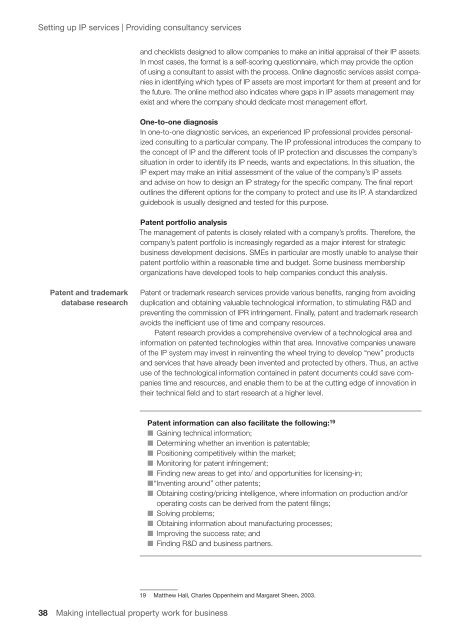Making intellectual property work for business - World Intellectual ...
Making intellectual property work for business - World Intellectual ...
Making intellectual property work for business - World Intellectual ...
Create successful ePaper yourself
Turn your PDF publications into a flip-book with our unique Google optimized e-Paper software.
Setting up IP services | Providing consultancy services<br />
Patent and trademark<br />
database research<br />
38 <strong>Making</strong> <strong>intellectual</strong> <strong>property</strong> <strong>work</strong> <strong>for</strong> <strong>business</strong><br />
and checklists designed to allow companies to make an initial appraisal of their IP assets.<br />
In most cases, the <strong>for</strong>mat is a self-scoring questionnaire, which may provide the option<br />
of using a consultant to assist with the process. Online diagnostic services assist companies<br />
in identifying which types of IP assets are most important <strong>for</strong> them at present and <strong>for</strong><br />
the future. The online method also indicates where gaps in IP assets management may<br />
exist and where the company should dedicate most management ef<strong>for</strong>t.<br />
One-to-one diagnosis<br />
In one-to-one diagnostic services, an experienced IP professional provides personalized<br />
consulting to a particular company. The IP professional introduces the company to<br />
the concept of IP and the different tools of IP protection and discusses the company’s<br />
situation in order to identify its IP needs, wants and expectations. In this situation, the<br />
IP expert may make an initial assessment of the value of the company’s IP assets<br />
and advise on how to design an IP strategy <strong>for</strong> the specific company. The final report<br />
outlines the different options <strong>for</strong> the company to protect and use its IP. A standardized<br />
guidebook is usually designed and tested <strong>for</strong> this purpose.<br />
Patent portfolio analysis<br />
The management of patents is closely related with a company’s profits. There<strong>for</strong>e, the<br />
company’s patent portfolio is increasingly regarded as a major interest <strong>for</strong> strategic<br />
<strong>business</strong> development decisions. SMEs in particular are mostly unable to analyse their<br />
patent portfolio within a reasonable time and budget. Some <strong>business</strong> membership<br />
organizations have developed tools to help companies conduct this analysis.<br />
Patent or trademark research services provide various benefits, ranging from avoiding<br />
duplication and obtaining valuable technological in<strong>for</strong>mation, to stimulating R&D and<br />
preventing the commission of IPR infringement. Finally, patent and trademark research<br />
avoids the inefficient use of time and company resources.<br />
Patent research provides a comprehensive overview of a technological area and<br />
in<strong>for</strong>mation on patented technologies within that area. Innovative companies unaware<br />
of the IP system may invest in reinventing the wheel trying to develop “new” products<br />
and services that have already been invented and protected by others. Thus, an active<br />
use of the technological in<strong>for</strong>mation contained in patent documents could save companies<br />
time and resources, and enable them to be at the cutting edge of innovation in<br />
their technical field and to start research at a higher level.<br />
Patent in<strong>for</strong>mation can also facilitate the following: 19<br />
■■<br />
Gaining technical in<strong>for</strong>mation;<br />
■■<br />
Determining whether an invention is patentable;<br />
■■<br />
Positioning competitively within the market;<br />
■■<br />
Monitoring <strong>for</strong> patent infringement;<br />
■■<br />
Finding new areas to get into/ and opportunities <strong>for</strong> licensing-in;<br />
■■“Inventing<br />
around” other patents;<br />
■■<br />
Obtaining costing/pricing intelligence, where in<strong>for</strong>mation on production and/or<br />
operating costs can be derived from the patent filings;<br />
■■<br />
Solving problems;<br />
■■<br />
Obtaining in<strong>for</strong>mation about manufacturing processes;<br />
■■<br />
Improving the success rate; and<br />
■■<br />
Finding R&D and <strong>business</strong> partners.<br />
19 Matthew Hall, Charles Oppenheim and Margaret Sheen, 2003.

















